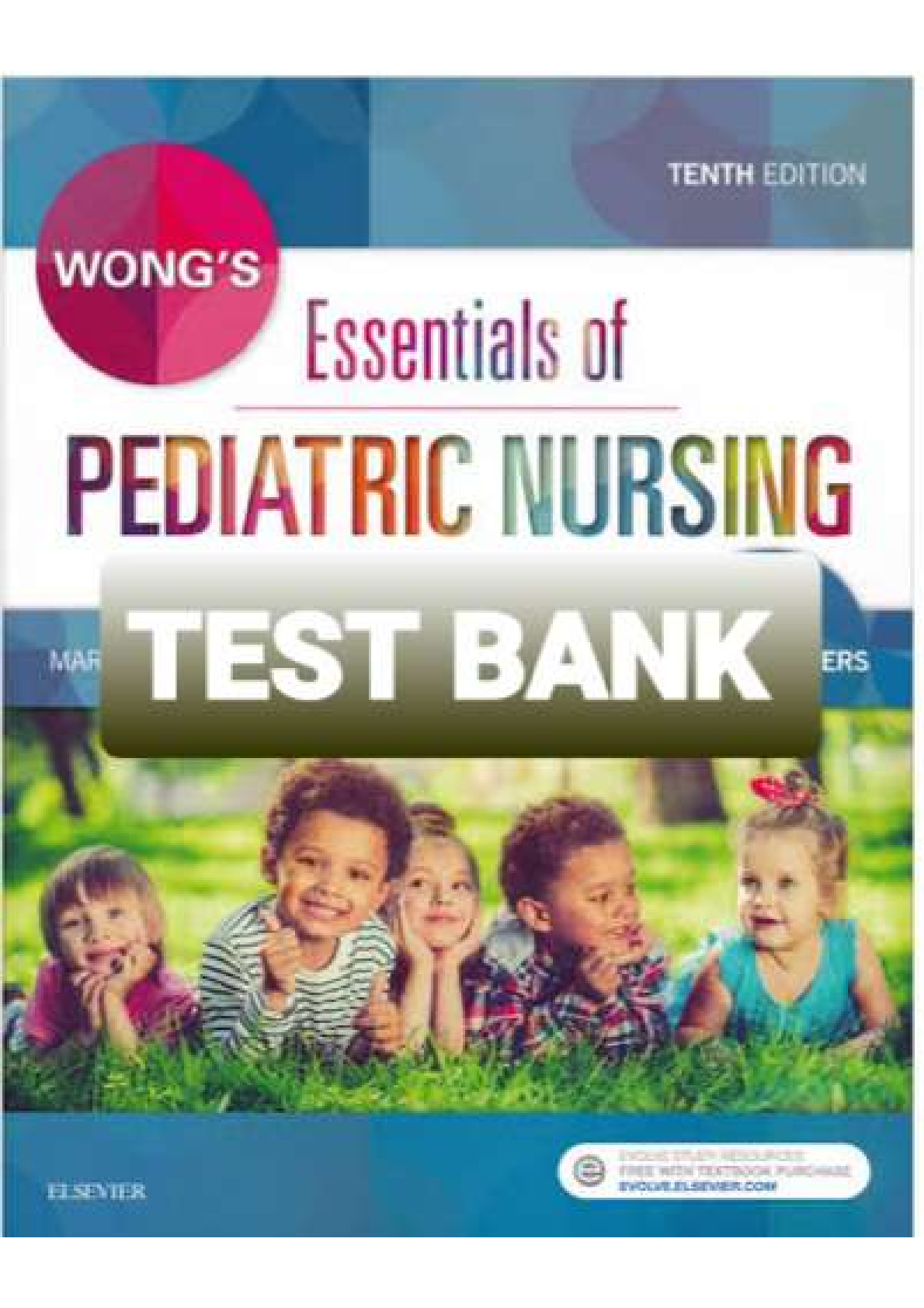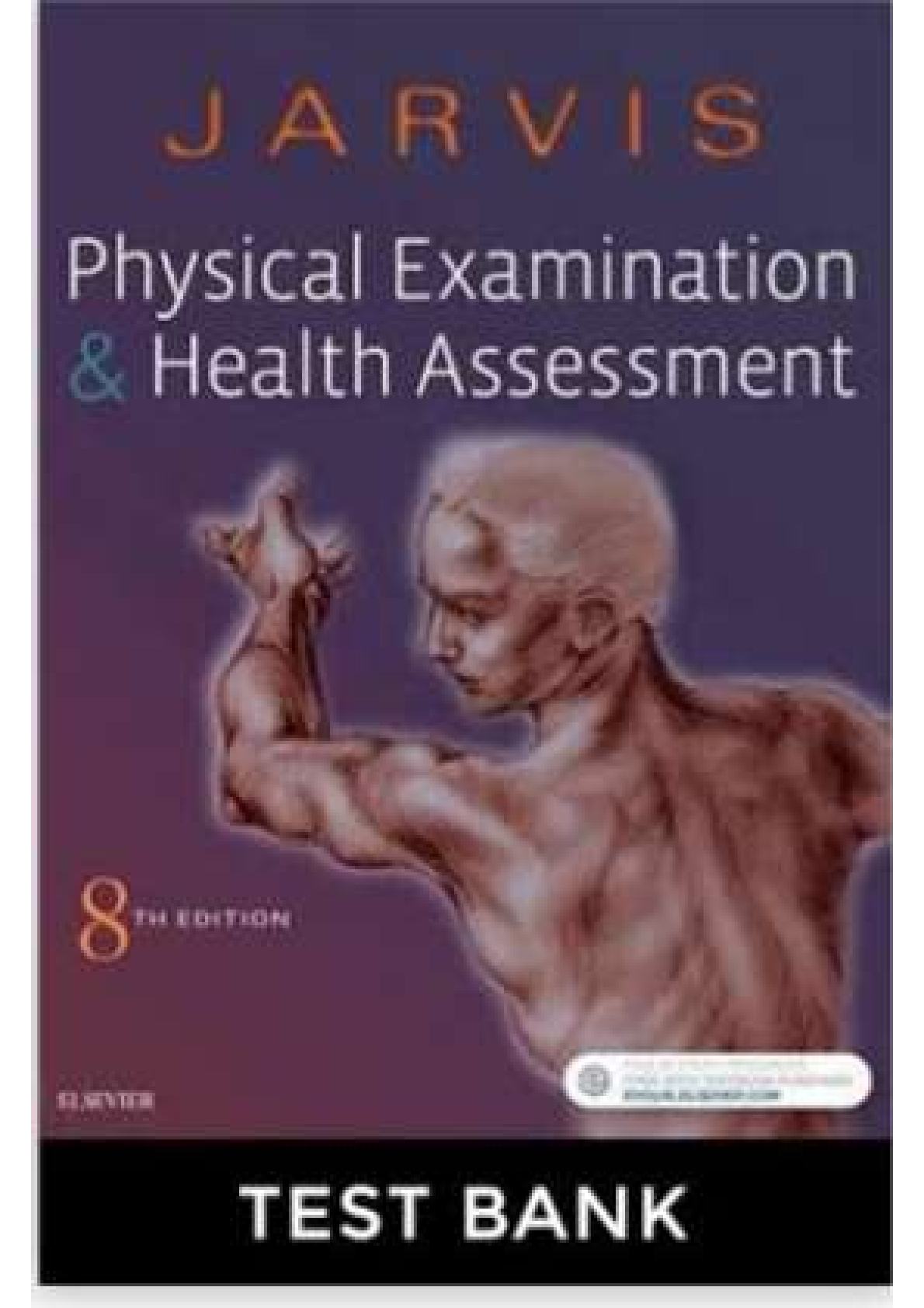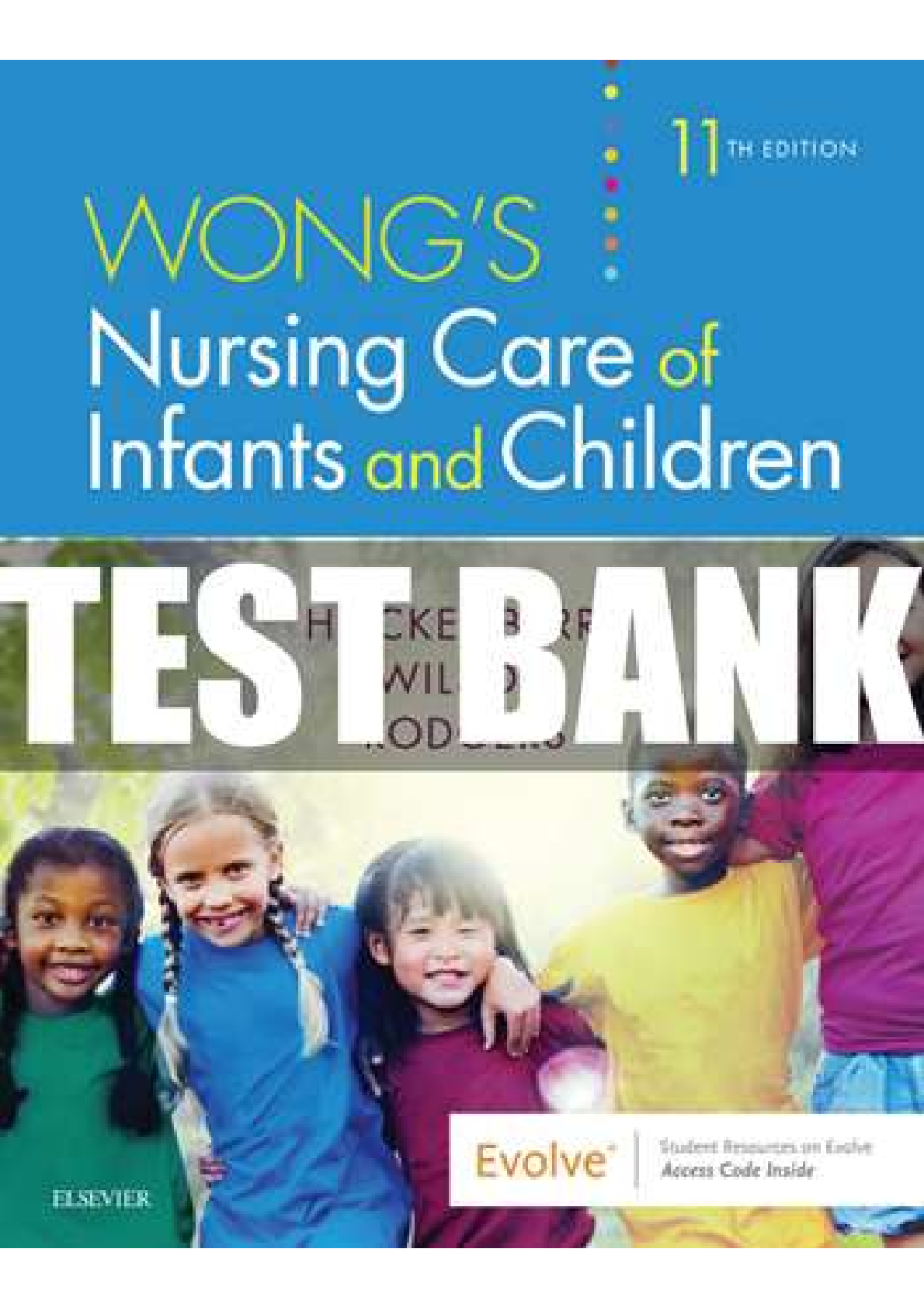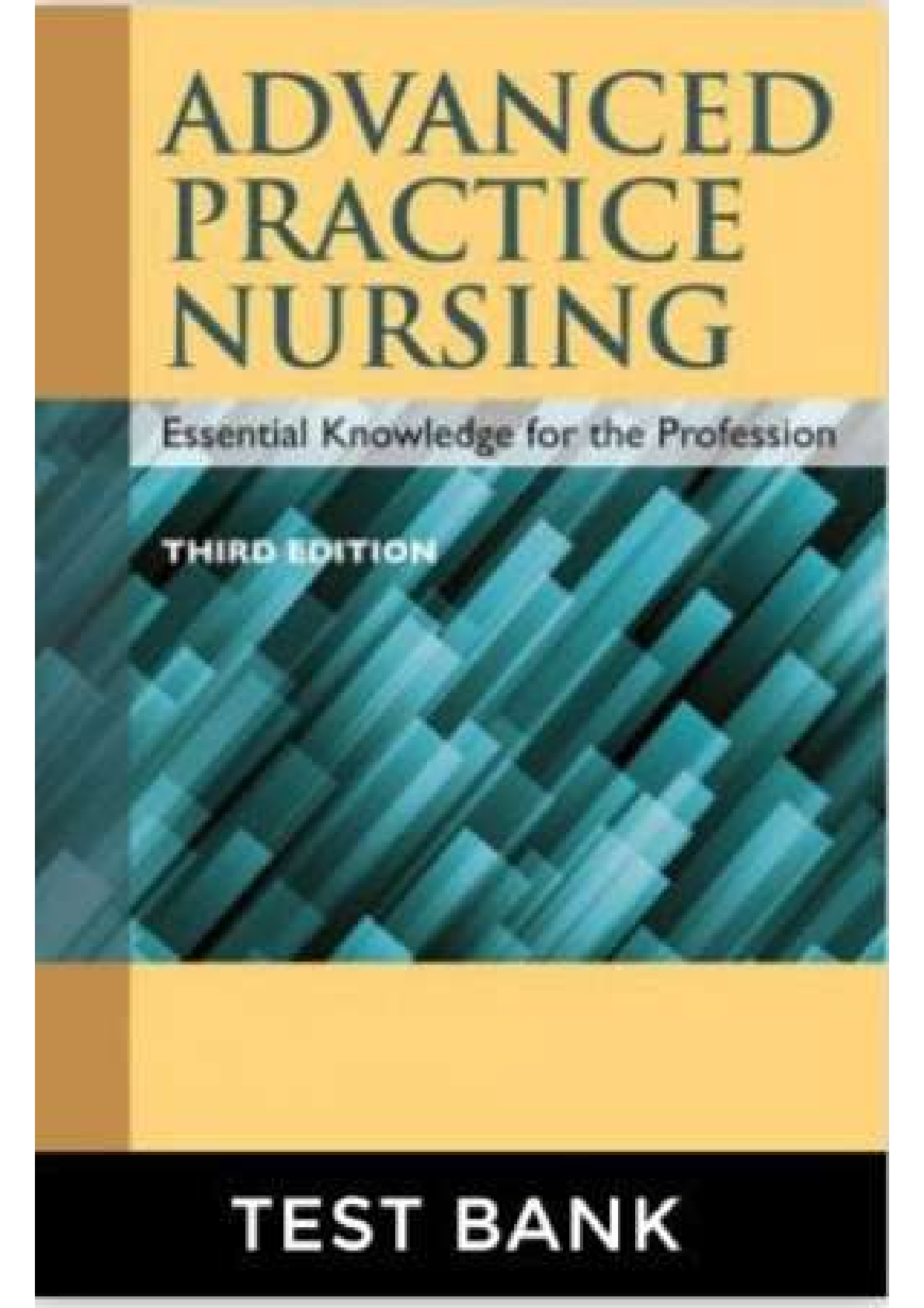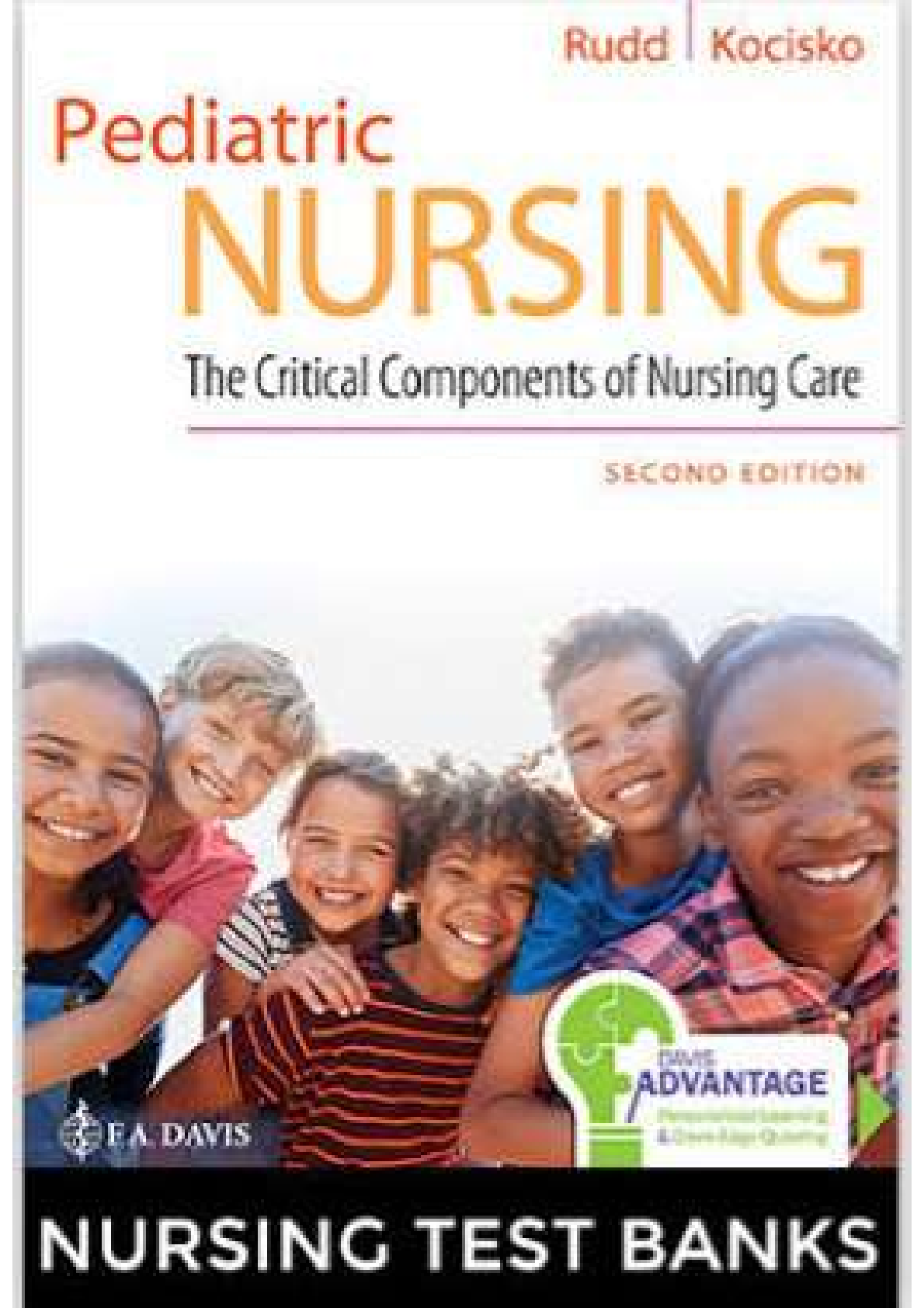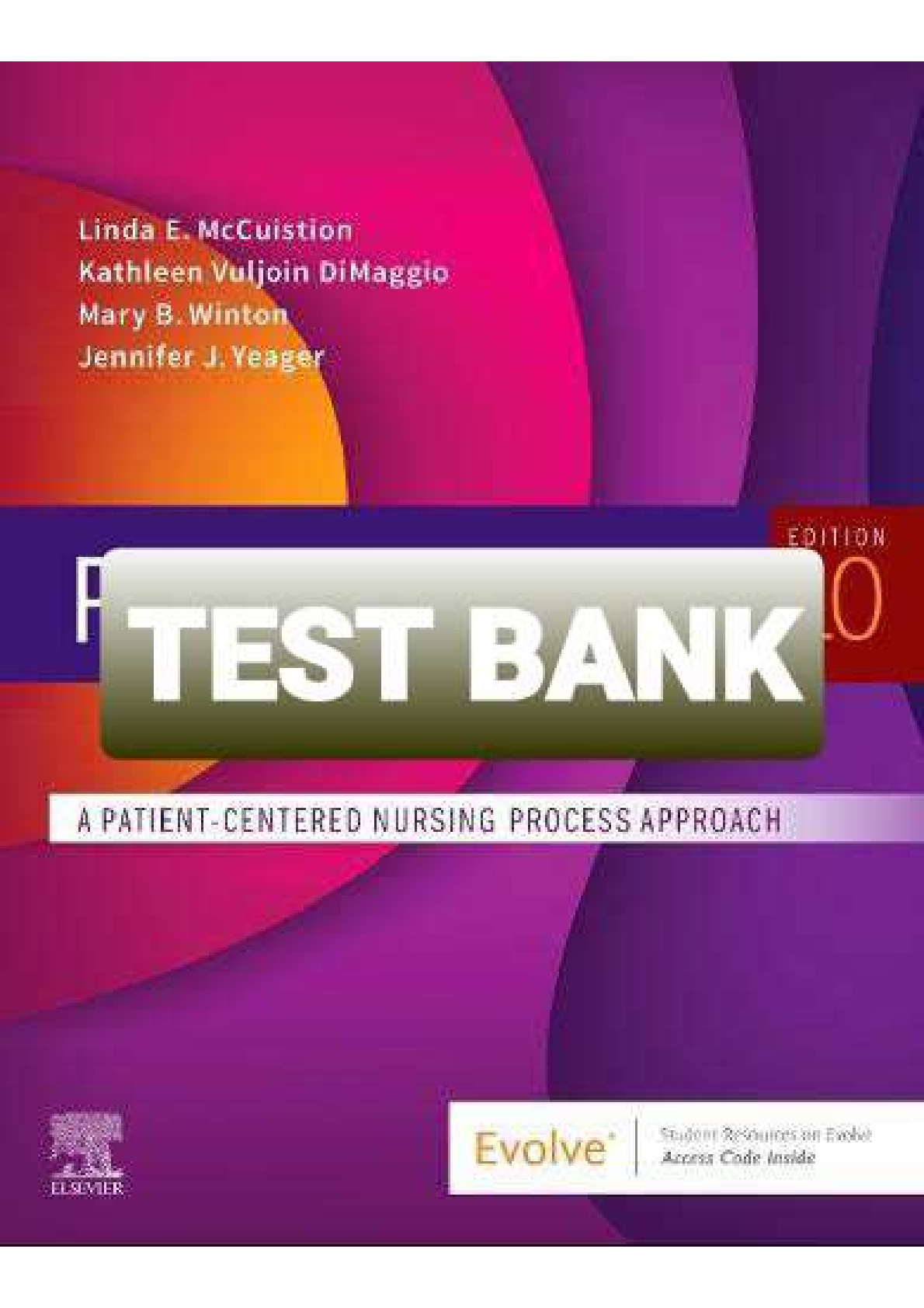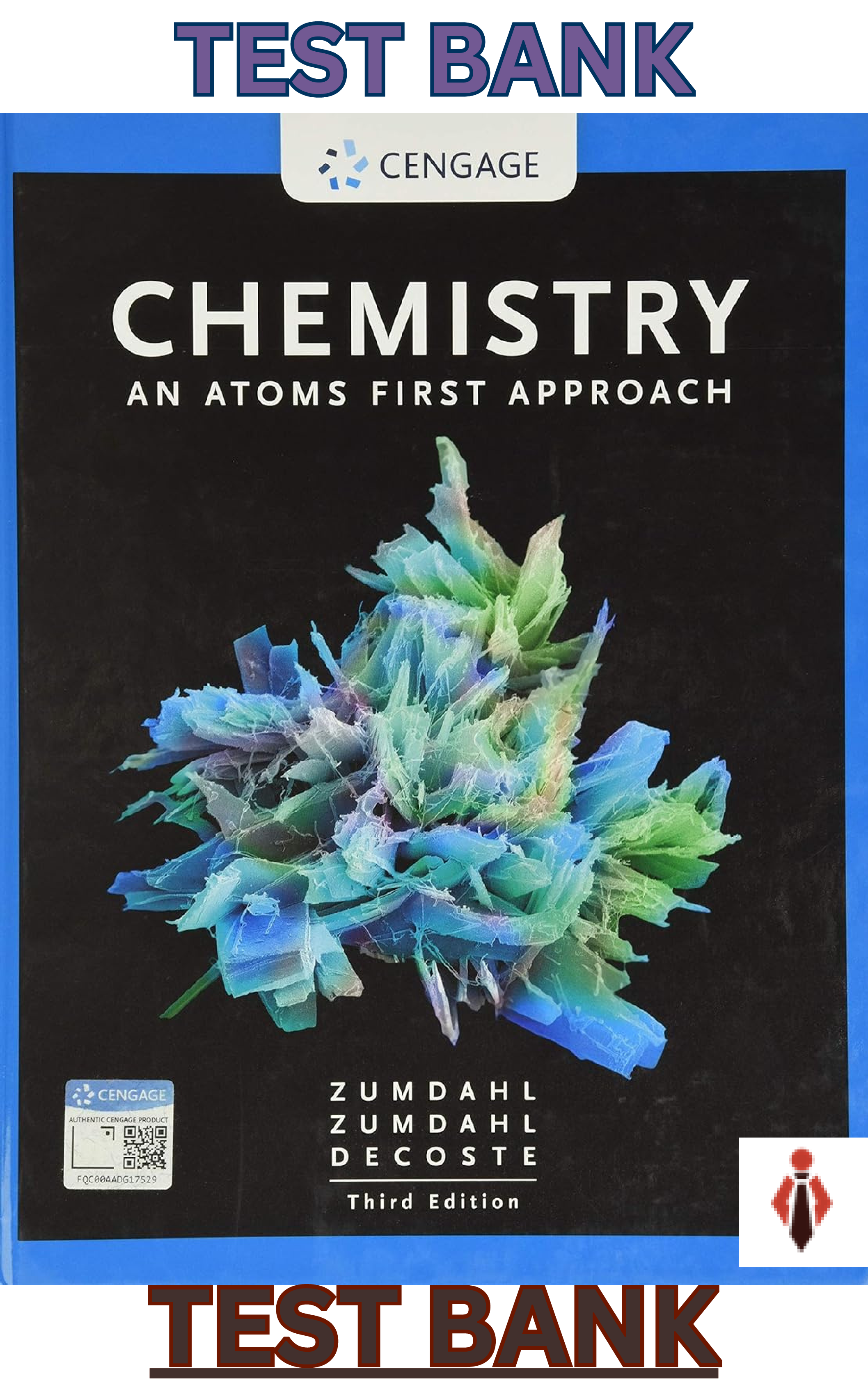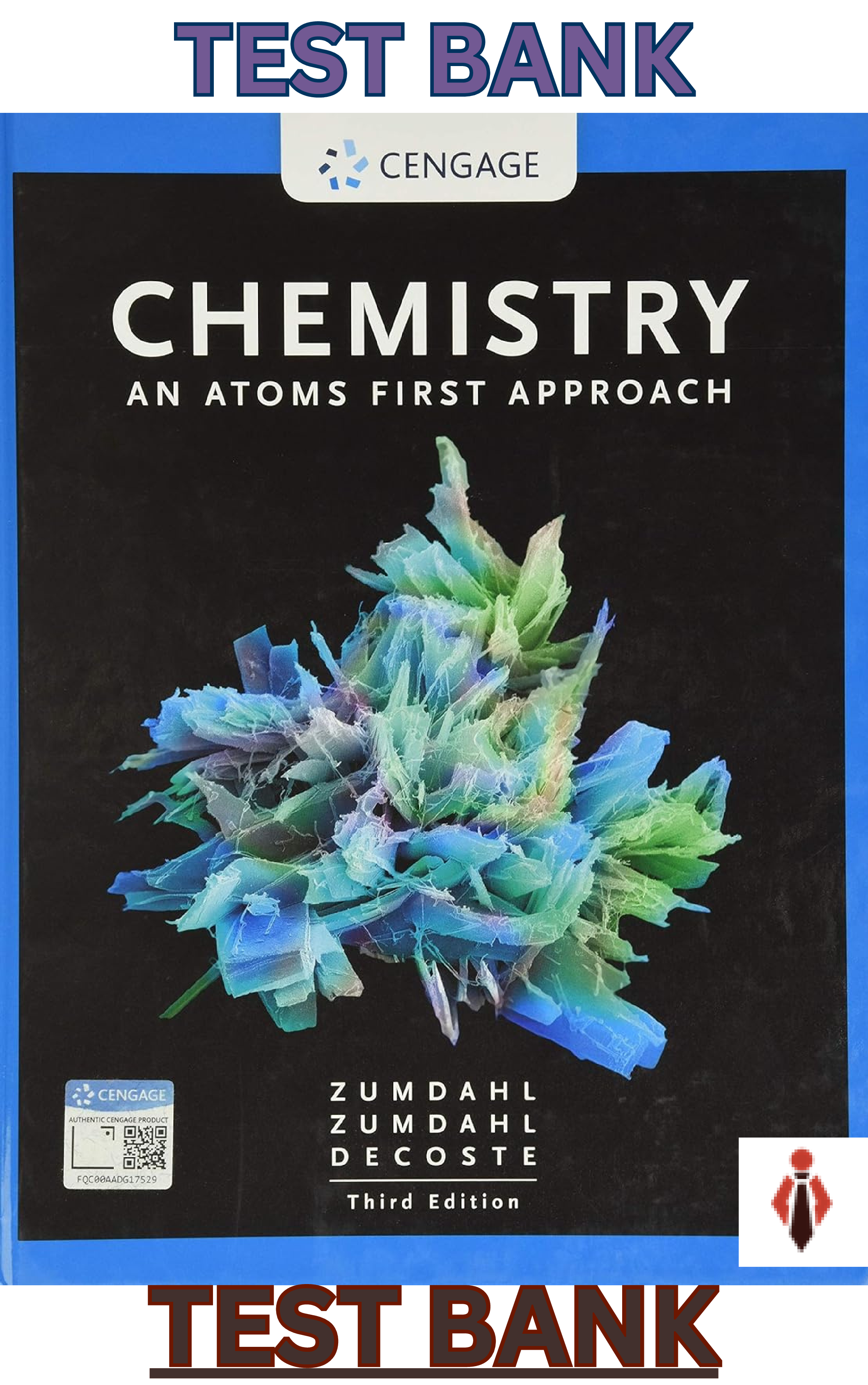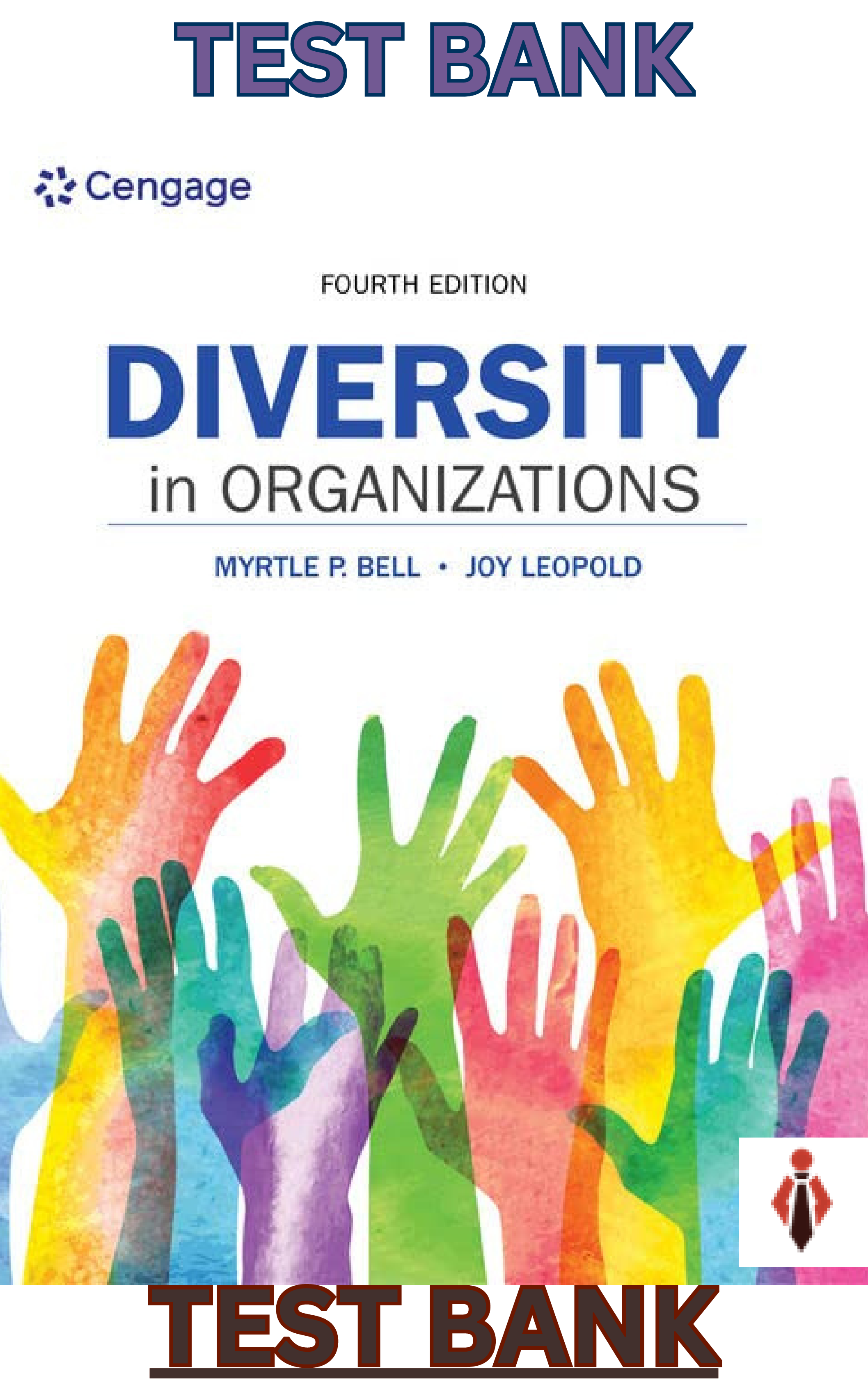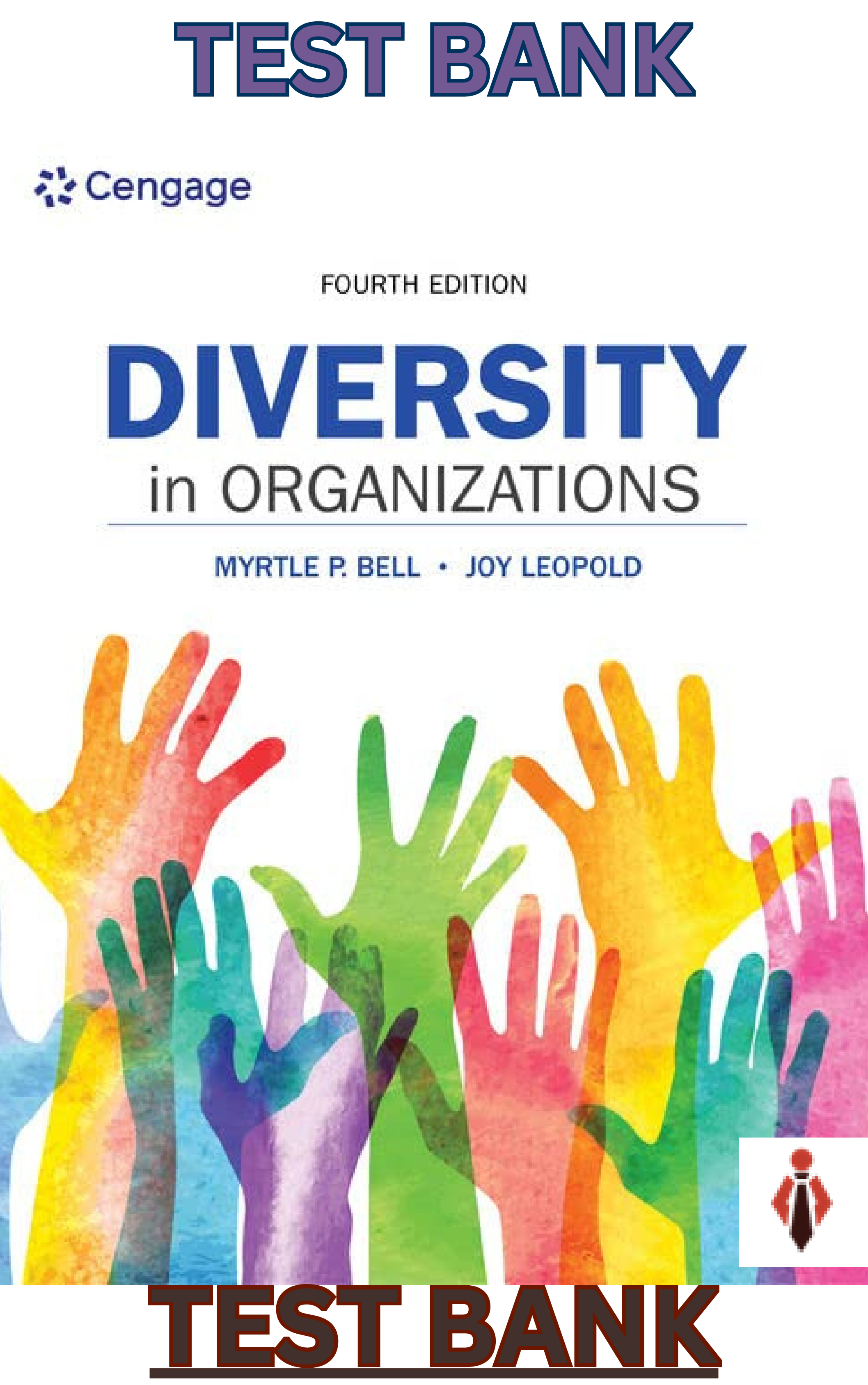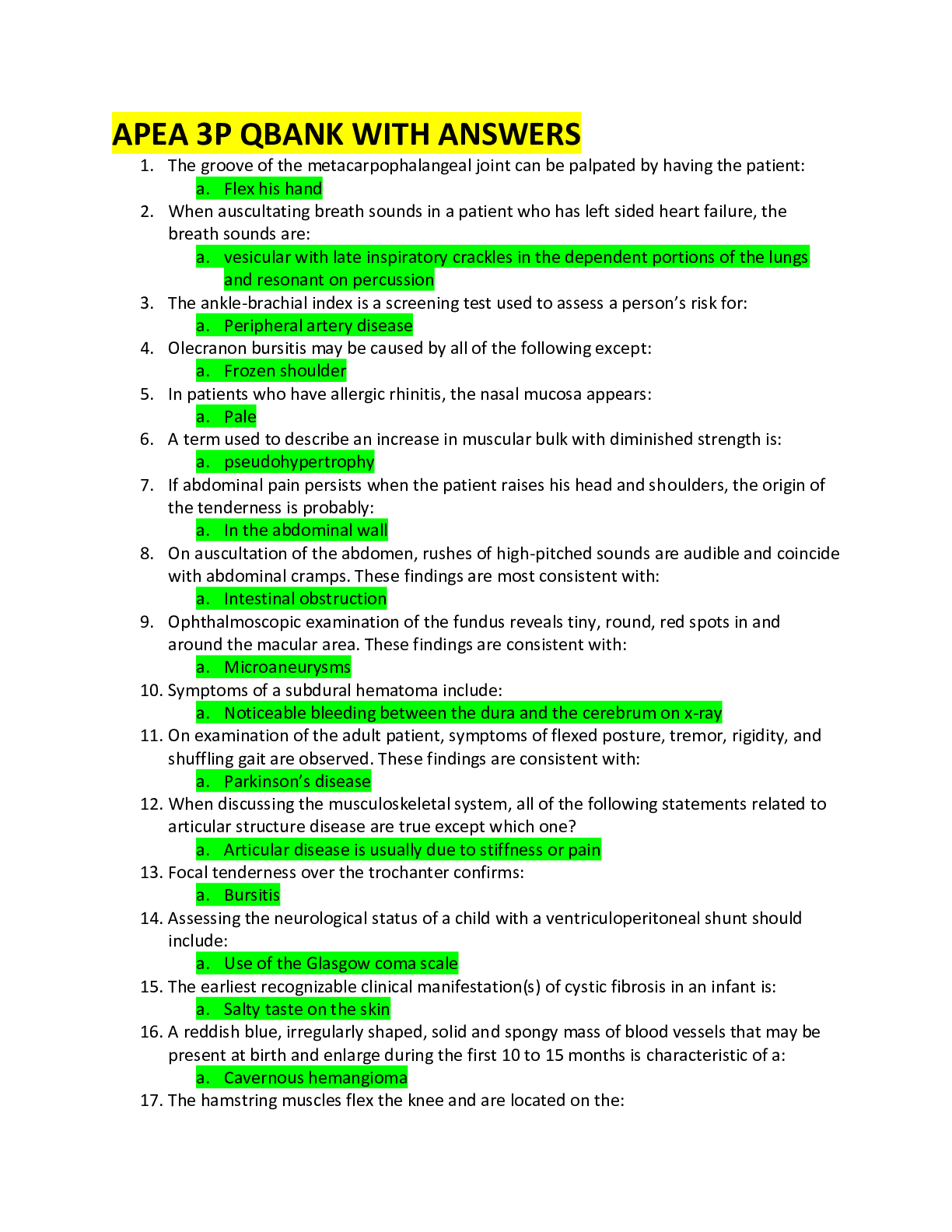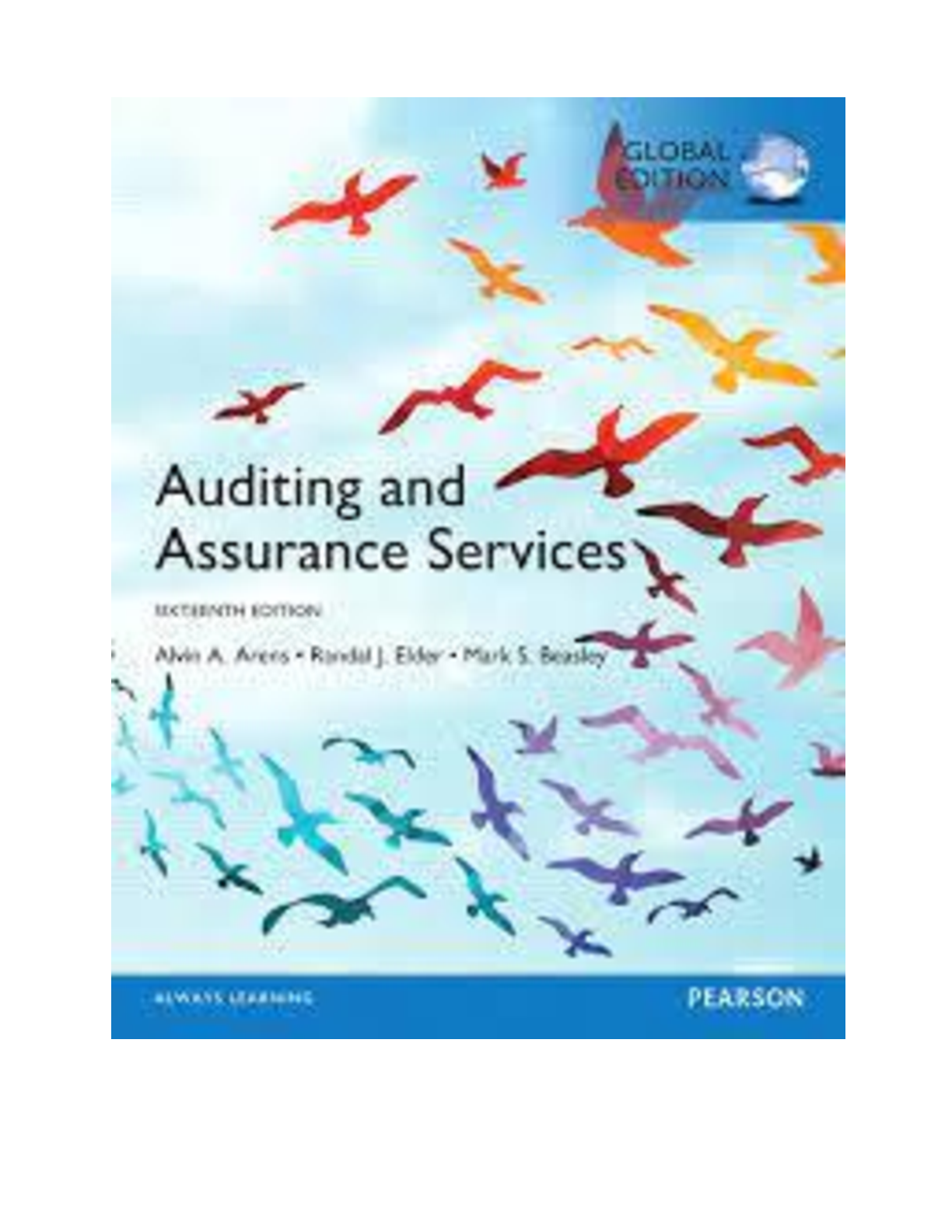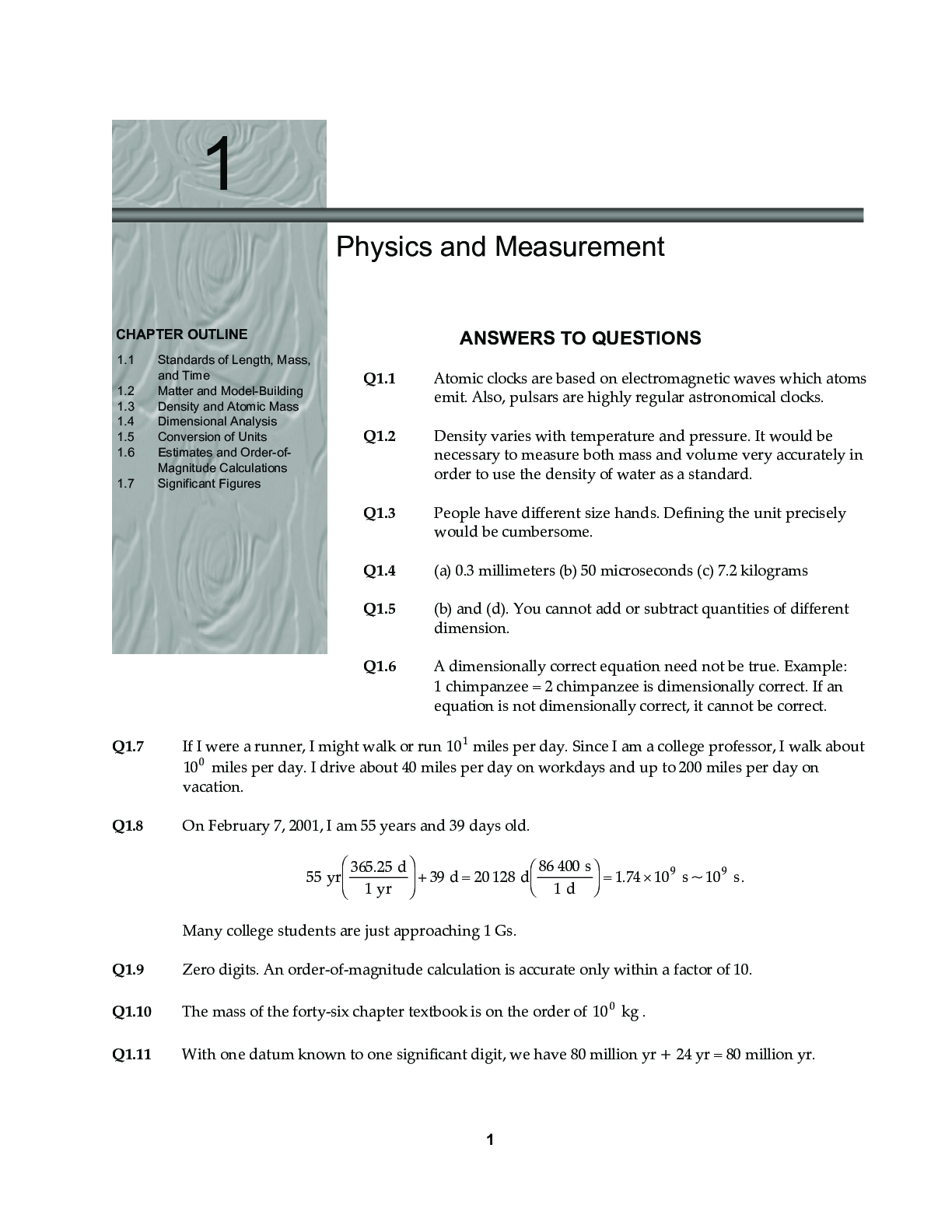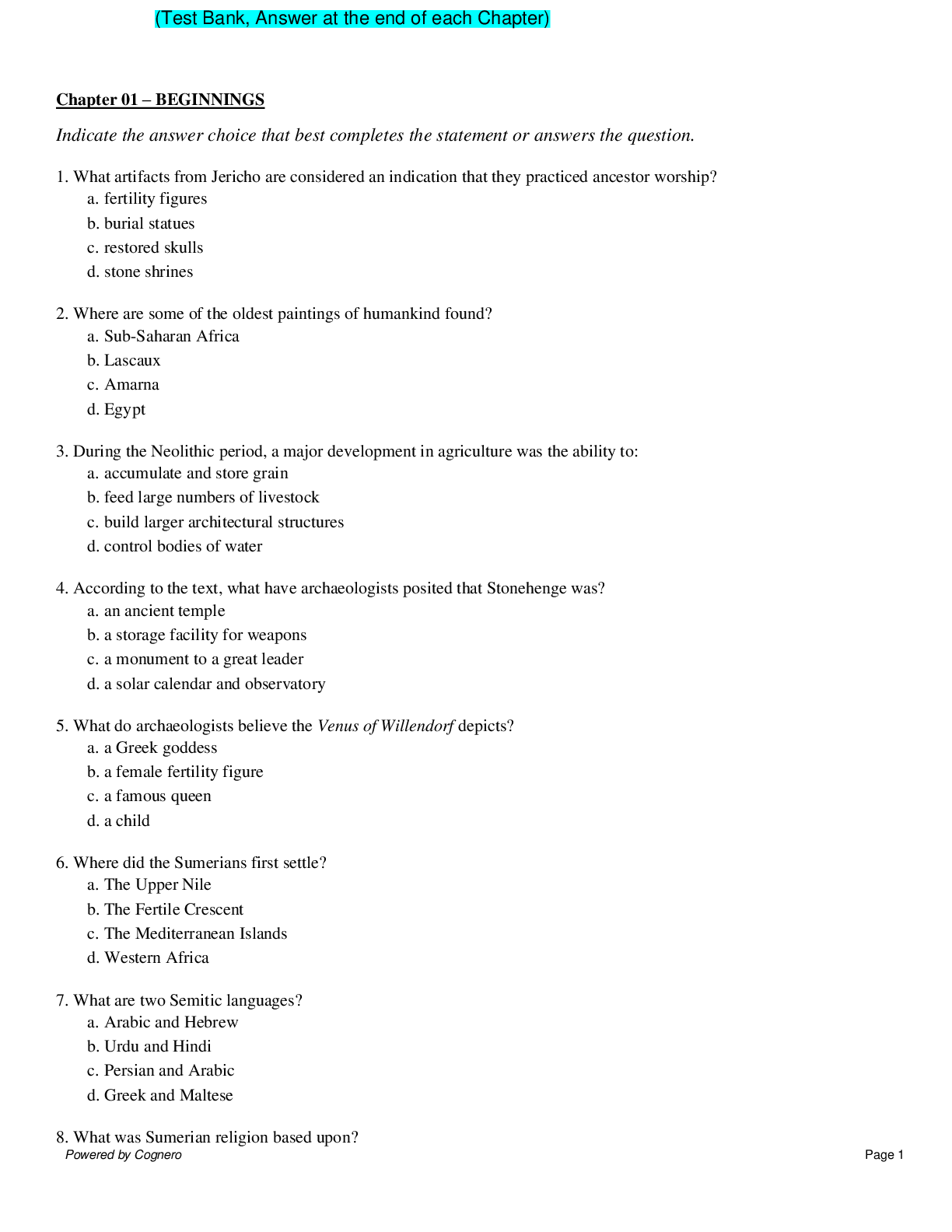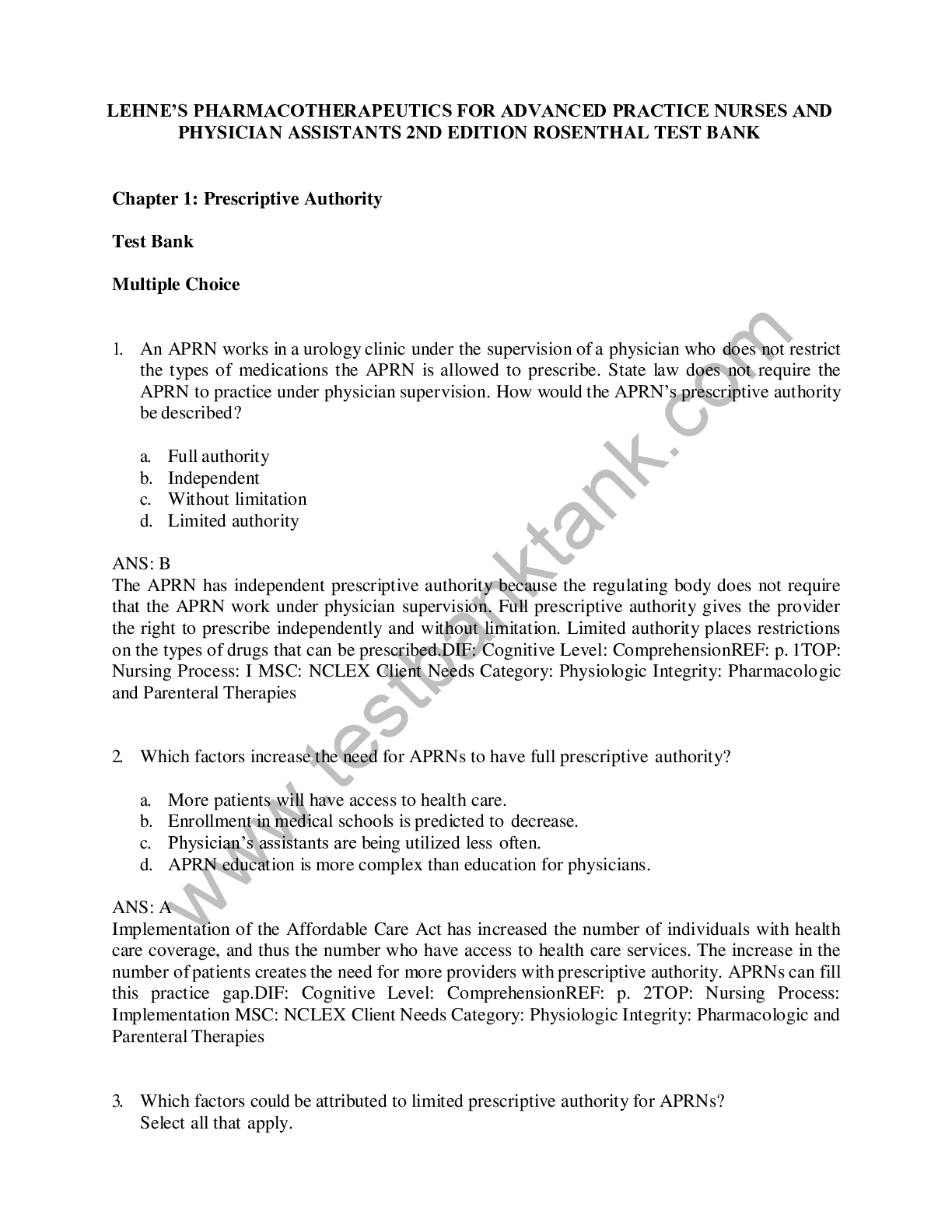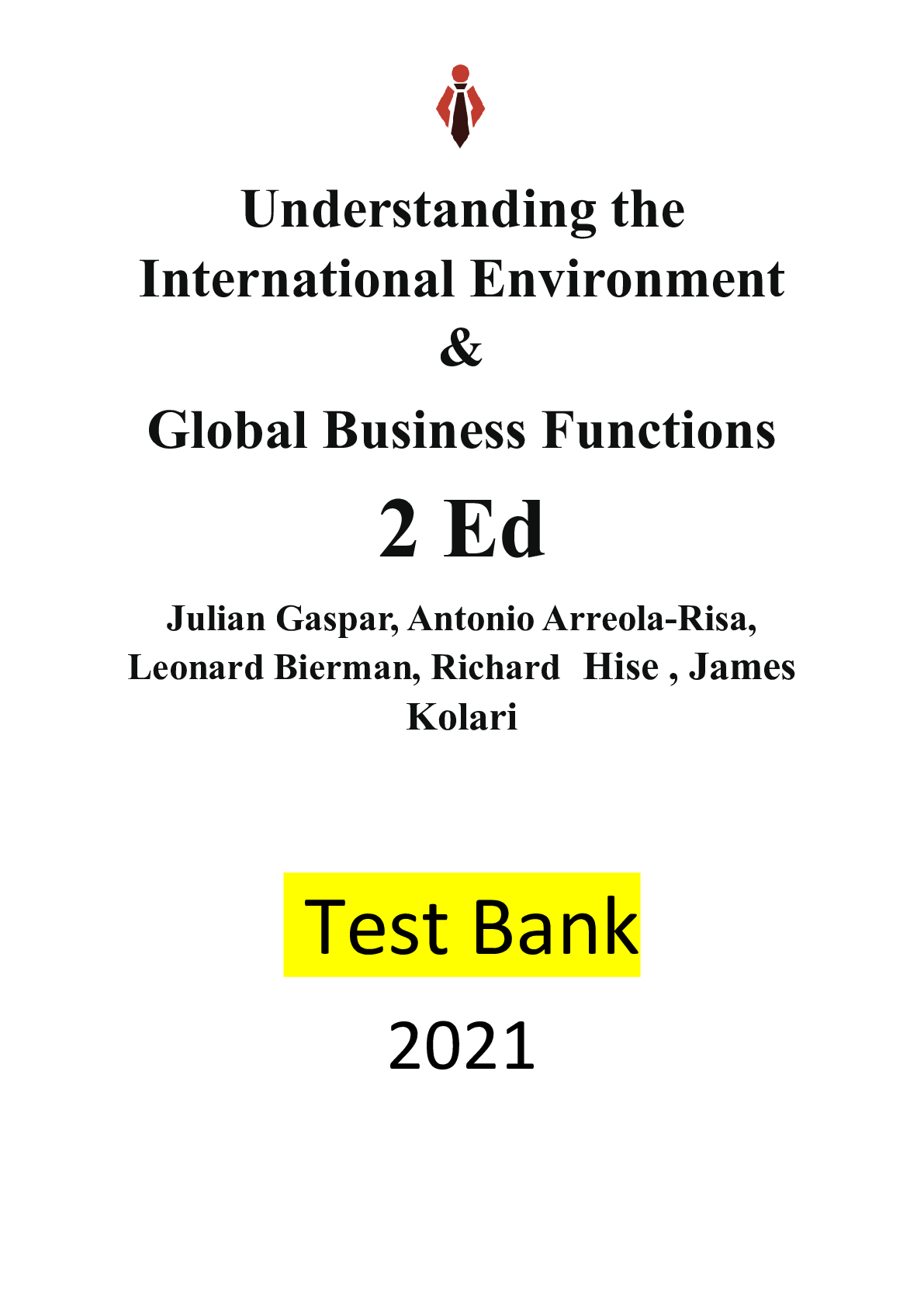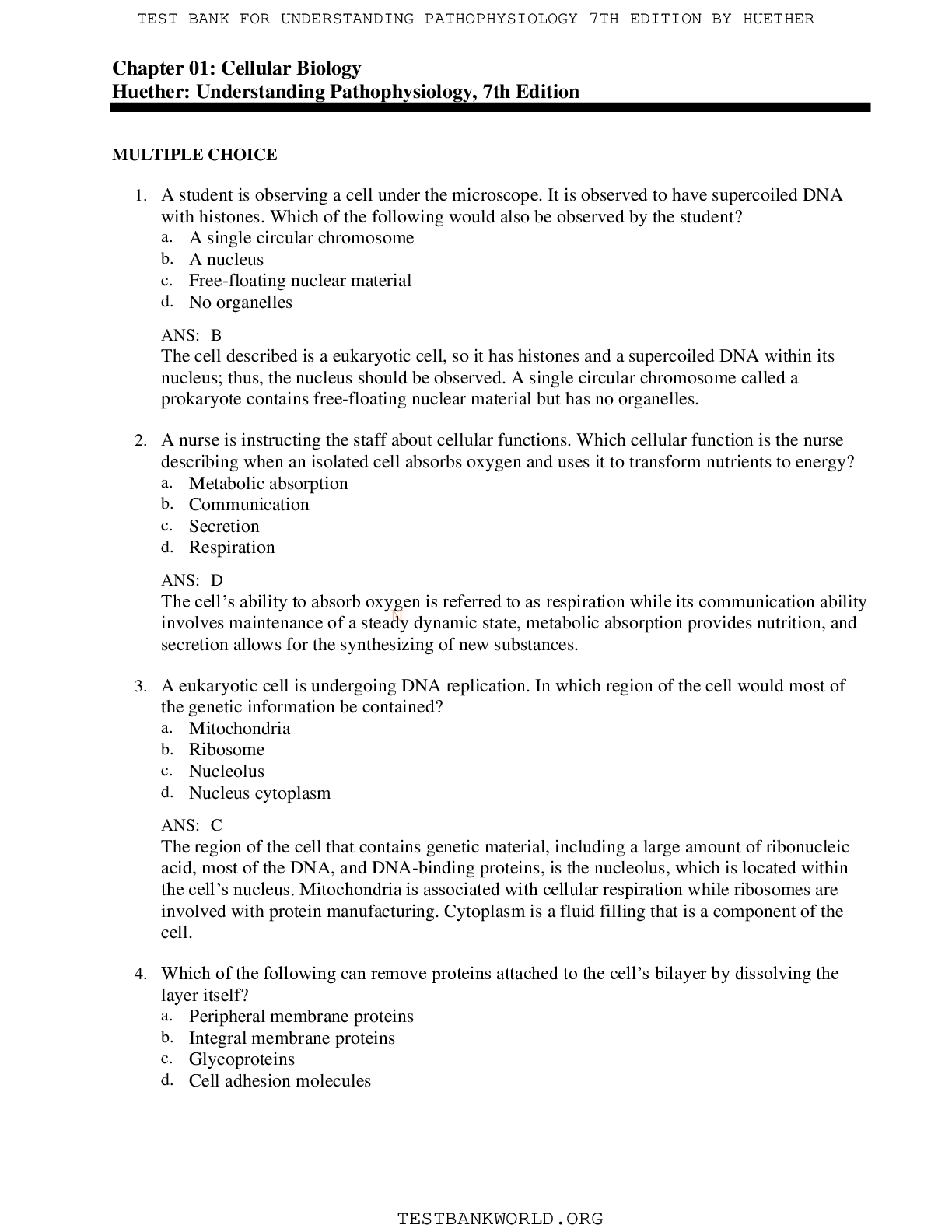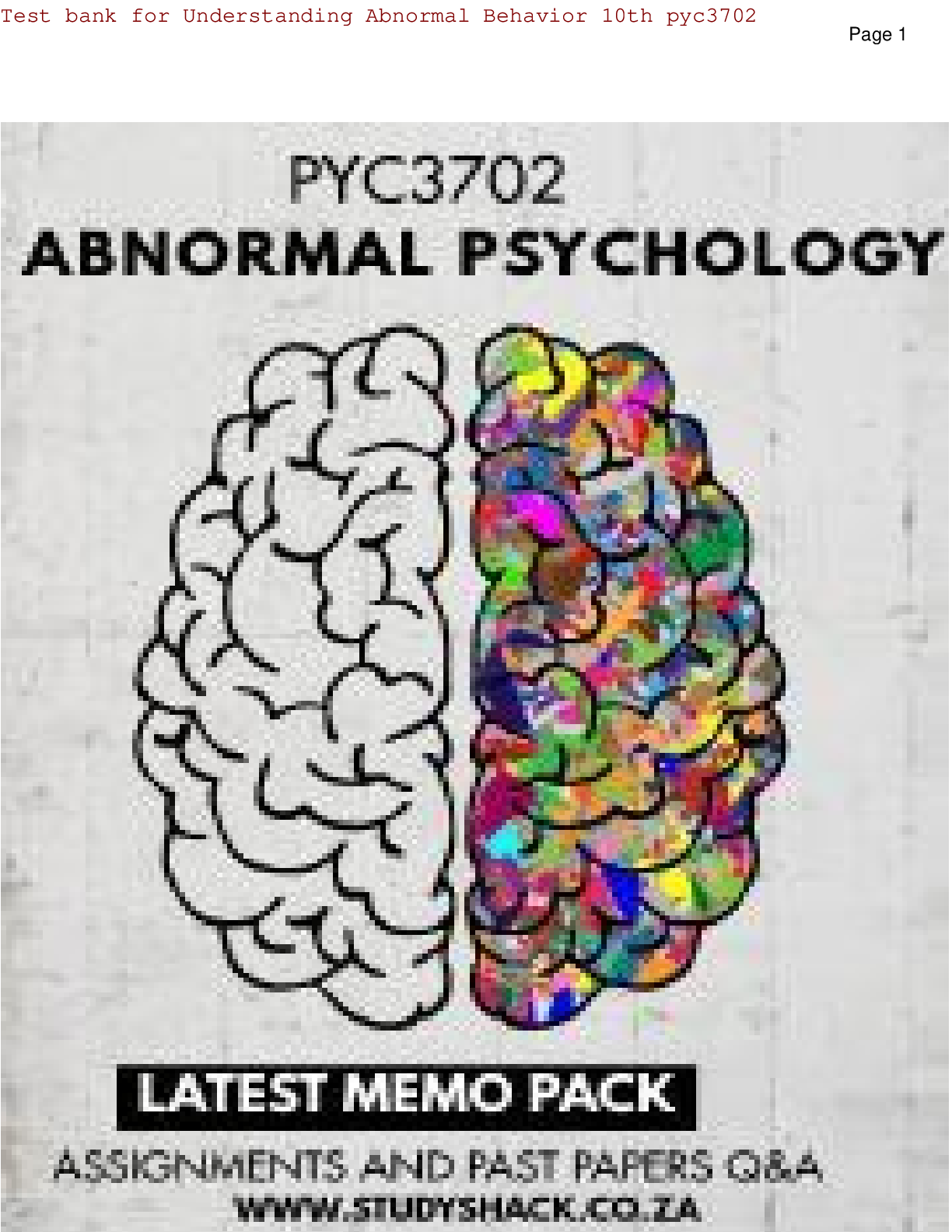Military Studies > TEST BANK > TEST BANK MILITARY 101 SEJPME I & II FINAL EXAM (SOLVED) Test Bank with Complete Questions and Solut (All)
TEST BANK MILITARY 101 SEJPME I & II FINAL EXAM (SOLVED) Test Bank with Complete Questions and Solutions 72 PAGES
Document Content and Description Below
TEST BANK MILITARY 101 SEJPME I & II FINAL EXAM (SOLVED) Test Bank with Complete Questions and Solutions 72 PAGES 1) The Missile Defense Agency (MDA) works with the combatant commanders (CCDRs) of t... he _____. (Select all that apply.) b, c, d a) None of the answers are correct b) United States Strategic Command (USSTRATCOM) c) United States Northern Command (USNORTHCOM) d) United States Pacific Command (USPACOM) 2) The main difference between Dining-In and Dining-Out for members of the Air Force is that spouses and other non-military guests may attend a Dining-In. b a) True b) False 3) Which of the following are keys to success in joint assignments? (Select all that apply.) b, c, d a) Checking the work of members from other Services b) Knowing the people around you c) Having competence in your area of the Service d) Knowing how to solve problems 4) Today, the U.S. and its partners find themselves in an era in which they are unlikely to be fully at war or fully at peace. a a) True b) False 5) If something of an ethical nature is ever in doubt, commanders should contact their legal counsel for advice. a a) True b) False 6) There are a total of how many Reserve Components in the Armed Forces of the United States? d 1. 8 2. 5 3. 6 4. 7 7) The ______ is an interagency staff group that establishes or enhances regular, timely, and collaborative working relationships between other government agency (e.g., CIA, DOS, FBI) representatives and military operational planners at the combatant commands. c a) JIACG b) HAST c) CMOC d) POLAD 8) Which of the following are considerations when hosting a formal dinner? a a) all of the answers are correct b) identify unique cultural considerations in a foreign country c) begin planning months in advance with the proposed guest list d) print and mail invitations four to six weeks in advance e) plan the menu and walk through the upcoming evening's sequence of events 9) The cornerstone of ARSOAC, the _____, is organized into four like battalions and provides nighttime, all-weather, medium range insertion, extraction, and resupply capability in hostile or denied areas. c a) 106th Special Operations Helicopter Regiment b) 101st Airborne Division (Air Assault) c) 160th Special Operations Aviation Regiment d) 3rd Combat Aviation Brigade 10) The National Security Council comprises of which three levels of formal interagency committees for coordination and making decision on national security issues? c a) executive, deputies, and interagency coordination b) principals, deputies, and interagency policy c) strategic, operational, and tactical d) principals, deputies, and interagency working group 11) In a traditional cake-cutting ceremony the first piece of cake is given to the youngest Marine present, and the second piece of cake is given to the oldest Marine present. a a) True b) False 12) During the early 1990s, what event shifted the focus of the Army's activities toward the stopping old rivalries and conflicts? c a) the collapse of the Warsaw Pact b) the rise of global terrorism c) the end of the Cold War d) the breakup of the Soviet Union into smaller states 13) The U.S. continues to become more dependent on the global domain within the information environment consisting of the interdependent network of information technology infrastructures, including the Internet, telecommunications networks, computer systems, and embedded processors and controllers. It is imperative that we safeguard this domain known as _____. d a) space b) networks c) information d) cyberspace 14) In 1798, the U.S. Navy and U.S. Marine Corps were created. a a) True b) False 15) Receiving realistic training, understanding the types of situations encountered in war, eating well, getting enough rest, and having meaningful relationships and friendships are all helpful in building _____ to the challenges and strains of military service. a a) resilience b) opposition c) vulnerability d) indifference 16) Which of the following represent highlights of Air Force history? a a) Thall of the answers are correct b) expansion into space c) design of a doctrine of strategic bombing and one of organizational independence d) development of the Strategic Air Command 17) Under the U.S. Constitution, the Congress has the power to _____. d a) close the U.S. borders b) declare war, raise and support Armies, provide and support a Navy, make rules for the government and regulation of the land and naval forces c) provide tanks and other equipment of war for Canada and Mexico d) declare war, support allied armies, and provide ships for allied navies 18) Devised to survive on a potentially atomic battlefield, vertical envelopment enabled Marines to achieve which of the following? b a) night missions b) speed and dispersion c) beachhead assaults 19) Successful teamwork in the joint environment requires trust, confidence and _____. d a) close supervision b) time to develop c) clear rules of engagement d) cooperation 20) The Joint Task Force commander facilitates unified action and gains a greater understanding of the roles of IGOs and NGOs and how they influence mission accomplishment by establishing a _____. d a) Civil-Military Operations Center (CMOC) b) Joint Interagency Coordination Group (JIACG) c) Humanitarian Assistance Coordination Center (HACC) d) Interagency Policy Committee (IPC) 21) During joint operation planning, joint force commanders should begin to coordinate their activities with other agencies _____. c a) when the combatant commander authorizes the plan b) after the operation plan has been finalized c) as early as possible d) after the ambassador reviews the operation plan 22) Reserve Component leaders agree that they receive adequate funding to support all levels of operational use identified by Service and Department of Defense plans. b a) True b) False 23) The primary function of the Air Force is to provide prompt and sustained offensive and defensive air operation. a a) True b) False 24) _____ is a hostile environment that often presents complex emotional and ethical dilemmas. c a) Major combat operations b) Irregular warfare environment c) Support for civil authorities d) Humanitarian assistance operations 25) _____ and _____ are two key structural enhancements that should improve the coordination of multinational forces. d a) Interoperability, liaison network b) Rationalization, training c) Training, interoperability d) Liaison network, coordination centers 26) During the Total Force Fitness ((TFF) Program section of the course, we discussed the importance of leader involvement. Leaders must identify the metrics that will set the right conditions to promote total fitness. In order to accurately assess the TFF program's effectiveness, metrics must be _____ . c a) challenging b) feasible c) quantitative d) observable 27) To reach the national strategic end state and conclude an operation successfully, commanders must integrate and synchronize stability operations with offensive and defensive operations. Planning for stability operations should begin _____. a a) when major combat operations have concluded b) upon declaration of a cease-fire c) when Phase IV - Stabilize begins d) when joint operation planning is initiated 28) Which of the following examples embodies Navy traditions and core values of honor, courage, and commitment? a a) "Don't give up the ship!" b) all of the answers are correct c) "Can you go and do likewise?" d) "Surrender? I have not yet begun to fight!" 29) Many external factors impact the psychological health of individuals. The culture of the military and its expectations and the _____ cycles require frequent change and adjustment. b a) weather b) deployment/redeployment c) training d) promotion 30) In the Chairman's White Paper, "Mission Command" (2012), the Joint Force of the future will find themselves operating in a security environment that is _____. b a) predictable b) dynamic c) ill-prepared d) segregated 31) What Services were established as precursors to the Coast Guard? (Select all that apply.) a, b, d a) Steamboat Inspection Service b) Life Saving Service c) Transportation Security Administration d) Lighthouse and Revenue Cutter Service e) Bureau of Navigation 32) Frequently a decisive element, the _____ principle of joint operations is based on the legality, morality, and rightness of the actions undertaken. b a) patience b) objective c) restraint d) legitimacy 33) Developing and maintaining professional relationships with multinational partner's means _____. a a) recognizing that their training and education may differ, but it does not mean they are less dedicated or professional b) continually reinforcing our standards upon them c) continuously demonstrating our superiority over them d) treating them as professionals with limited skills 34) The multinational force commander must resolve or mitigate sovereignty through which of the following? (Select all that apply.) a, c a) coordination b) compromise c) communication d) consensus 35) The complexity and challenges associated with planning for and executing an operation includes: (Select all that apply). a, b, c, d a) intergovernmental b) interagency c) military d) multinational partners 36) Deliberations involving the possible use of force must include the Reserve Component at what point in the planning process? d a) late in the planning process b) after all of the planning is completed c) somewhere - early, mid, or later - as long as they are included d) early in the planning process 37) The end strength of the U.S. Coast Guard Reserve is _____ percent of the total Coast Guard. a a) 50 b) 30 c) 20 d) 10 38) The aspect of PME that focuses on imparting joint knowledge and attitudes is joint _____. d a) doctrine b) education c) concepts d) training 39) The seizure and defense of naval bases is provided by which branch of the Armed Services? b a) Coast Guard b) Marines c) Army d) Navy e) Air Force 40) The term joint force commander refers exclusively to the following three types of commanders: c a) joint task force commander, functional component commander, and subunified commander b) combatant commander, Service component commander, and functional component commander c) Service component commander, combatant commander, and joint task force commander d) combatant commander, subordinate unified commander, and joint task force commander 41) Ice Operations and Marine Environmental Protection fall under which role of the Coast Guard? a a) maritime stewardship b) maritime safety c) maritime security 42) The _____ organize, train, equip, and provide combat-ready forces to conduct operations as directed by the President and Secretary of Defense. a a) Joint Chiefs of Staff b) combatant commands c) joint task forces d) military departments 43) Flexibility in aerospace power allows forces to exploit mass and maneuver simultaneously to a far greater extent than surface forces can. a a) True b) False 44) The most well-known Coast Guard mascot during World War II, who provided a morale boost to his crew, was named? a a) Skipper b) Sinbad c) Aladdin d) Smoky 45) Each geographic combatant command has a _____ to plan and control special operations and other Special Operations Forces activities. c a) Joint Special Operations Task Force (JSOTF) b) Regional Special Warfare Command (RSWC) c) Joint Special Operations Command (JSOC) d) Theater Special Operations Command (TSOC) 46) Army Special Operations missions can include which of the following? (Select all that apply.) b, c, d a) major combat operations b) cyberspace operations c) training of foreign militaries d) humanitarian assistance 47) _____ is the process used to mitigate operational risks. Although created with military operations in mind, these procedures can be used to plan other activities. b a) Operational resource management b) Operational risk management c) Risk assurance d) Risk avoidance 48) Military-political considerations frequently cast special operations into clandestine or covert environments; therefore, their activities normally involve oversight at the _____ level. c a) tactical b) national c) joint task force d) operational 49) Under what circumstances may the Coast Guard be transferred to and operate as a service of the Navy? (Select all that apply.) a, b, c a) upon a declaration of war b) when directed by the President c) when ordered by the Secretary of Defense 50) In the Chairman's White Paper, "America's Military - A Profession of Arms," this aspect of the Armed Forces is identified as the foundation of our profession. d a) Values b) Legal Authority c) Leadership d) Honor 51. What WWII conference established the Joint Chiefs of Staff? a) U.S.-British Staff Conference (ABC-1) b) First Moscow Conference (RIVIERA) c) Casablanca Conference (SYMBOL) d) First Washington Conference (ARCADIA) 52. The 1986 Goldwater-Nicholas Act____. a) Added the Commandant of the Marine Corps as a permanent and participating member of the Joint Chiefs of Staff b) Clarified the chain of command and civilian control of the U.S. Military c) Provided the Chief of the National Guard Bureau full membership of the Joint chiefs of Staff 53. The Chairman of the Joint Chiefs of Staff provides a channel of communication between the President/SECDEF and the Combatant Commander. a) True b) False 54. National Security Agency (NSA) provides which of the following support: (Select all the apply) a) Solutions, products, and services b) Timely, relevant, and accurate geospatial intelligence c) Information systems security d) Signals intelligence 55. The North American Aerospace Defense Command(NORAD) is operated by which countries? (Select all that apply.) a) Canada b) Mexico c) United States d) Great Britain 56. The Missile Defense Agency (MDA) works with the Combatant Commanders (CCDRs) of which commands? (Select all that apply) a) United States Northern Command (USNNORTHCON) b) United States Pacific Command (USPACOM) c) United States Strategic Command(USSTRATCOM) 57. ______ is a violent struggle among state and non-state actors for legitimacy over the relevant population(s). It favors indirect and asymmetric approaches, though it may employ the full range of military and other capabilities, in order to erode an adversary’s power, influence, and will. a) Asymmetric Warfare b) Traditional Warfare c) Joint Warfare d) Irregular Warfare 58. The ability of the U.S. to achieve its national strategic objectives is dependent on the effectiveness is the U.S. Government in employing the instruments of national power, which are_____. a) Diplomatic, Informational, Military, and Economic b) Diplomacy, Defense, and Development c) Political, Military, Economic, Social, Informational, and Infrastructure d) Culture, Industry, Technology, and Geography 59. The President of the United States provides guidance for developing, applying, and coordinating the instruments of national power to achieve objectives that contribute to national security in the ____. a) National Defense Strategy b) National Security Strategy c) Unified Command Plan d) National Military Strategy 60. The _____, signed by the Chairman of the Joint Chiefs of Staff, provides guidance for distributing and applying military power to attain national strategic objectives. It describes the Armed Forces’ plan to achieve military objectives in the near term and provides the vision for ensuring they remain decisive in the future. a) Joint Strategic Capabilities Plan b) National Security Strategy c) National Defense Strategy d) National Military Strategy 61. The statutory members of the National Security Council are ____. a) President, Vice President, Secretary of State, Secretary of Defense, and Secretary of Energy b) President, Vice President, Secretary of Defense, and Secretary of State c) President, Vice President, Secretary of State, Secretary of Defense, and Secretary of Treasury d) President, Vice President, Secretary of Defense, and Security of Homeland Security 62. The _____ is the President’s principle forum for considering national security policy matters with his senior national security advisors and cabinet officials. a) Secretary of Homeland Security b) Secretary of Defense c) National Security Council d) Joint Chiefs of Staff 63. The operational chain of command runs directly from the President to the Secretary of Defense and then to the ____. a) Chairmen of the Joint Chief of Staff b) Chairmen of the Joint Chiefs of Staff and then to the Combatant Commanders c) Combatant Commanders d) Services Chiefs 64. The non-operational chain of command runs directly from the President to the Secretary of Defense and then to the. a) Service Chiefs via the Chairman of the Joint Chiefs of Staff b) Secretaries of the Military Departments and then to the Combatant Commanders c) Combatant Commanders via the Service Chiefs d) Secretaries of the Military Departments and then to the Service Chiefs 65. The _____ outranks all other offices of the Armed Forces, but may not exercise military command over any of the Armed Forces. This officer is the principle military advisor to the President, the National Security Council, and the Secretary of Defense. a) Chairmen of the Joint Chiefs of Staff b) Supreme Allied Commander c) Combatant Commander d) War Czar 66. A unified or Specified Command with a broad continuing mission under a single commander established and so designated by the President, through the Secretary of Defense and with the advice and assistance of the Chairman of the Joint Chiefs of Staff is called a _____. a) Joint Task Force b) Subordinate Unified Command c) Combatant Command d) Component Command 67. A _____ is a joint force that is constituted and so designated by the SecDef, a Combatant Commander, a Subordinate Unified Commander, or an existing JTF Commander to accomplish missions with specific, limited objectives and which do not require overall centralized control of logistics. It is dissolved when the purpose for which it was created had been achieved or when it is no longer required. a) Combatant Command b) Subordinate Unified Command c) Joint Task Force d) Service Component Command 68. The term Joint Force Commander refers exclusively to the following three (3) types of commanders: a) Combatant Commander, Subordinate Unified Commander, and Joint Task Force Commander b) Combatant Commander, Service Component Commander, and Functional Component Commander c) Joint Task Force Commander, Functional Component Commander, And Subunified Commander d) Service Component Commander, Combatant Commander, and Joint Task Force Commander 69. Joint Force Air Component (JFACC), Joint Force Land Component Commander (JFLCC), and Joint Force Maritime Component Commander (JFMCC) are all examples of _____. a) Joint Task Force Commanders b) Subunified Commanders c) Service Component Commanders d) Functional Component Commanders 70. These commands are established by Combatant Commanders when authorized by the SecDef through the CJCS to conduct operations on a continuing basis in accordance with the criteria set forth for Unified Commands. They may be established on a geographic area basis such as the United States Forces Japan or on a functional basis such as Special Operations Command, Pacific. a) Combatant Commands b) Subordinate Unified Commands c) Joint Task Forces d) Functional Component Commands 71. Combatant Commanders exercise _____ (command authority)) over assigned forces. This is the broadest command authority and may NOT be delegated or transferred. a) Administrative Control (ADCON) b) Operational Control (OPCON) c) Tactical Control (TACON) d) Combatant Command (COCOM) 72. _____ is the authority to perform those functions of command over subordinate forces involving organizing and employing commands and forces, assigned tasks, designating objectives, and giving authoritative direction necessary to accomplish the mission. It includes authoritative direction over all aspects of military operations and joint training necessary to accomplish missions assigned to the command. a) Combatant Command b) Operational Control (OPCON) c) Tactical Control (TACON) d) Administrative Control (ADCON) 73. The four categories of support are _____. a) General, tactical, operational, and strategic b) Tactical, operational, direct, and common c) General, mutual, direct, and close d) Reinforcing, mutual, complementary, and close 74. Which of the following are instruments of national power? (Select all that apply.) a) Economics b) Information c) The Military d) Diplomacy 75. The relevance of the interagency process at the strategic level to the Combatant Commander and the U.S. military is that the process yields America’s major national security policy decisions. a) True b) False 76. Provides commanders with an increased capability to coordinate with other U.S. Government agencies? a) Interagency Coordination b) DIME c) Annex V d) Joint Interagency Group (JIACG) e) Foreign Policy Advisor (POLAD) 77. The part of the CCRD’s Operation Plan that specifies not only the capabilities that military planners have determined the military may need, but also the interagency partners’ shared understanding of the situation, as well as the common objectives required to resolve the situation? a) Interagency Coordination b) DIME c) Annex V d) Joint Interagency Group (JIACG) e) Foreign Policy Advisor (POLAD) 78. The four most basic elements of national power? a) Interagency Coordination b) DIME c) Annex V d) Joint Interagency Group (JIACG) e) Foreign Policy Advisor (POLAD) 79. Providing U.S. Government foreign policy perspectives and diplomatic considerations, establishes linkages with U.S. embassies and State Department? a) Interagency Coordination b) DIME c) Annex V d) Joint Interagency Group (JIACG) e) Foreign Policy Advisor (POLAD) 80. The interaction that occurs between agencies of the U’S’ Government, including the Department of Defense (DoD), for the purpose of accomplishing the objective? a) Interagency Coordination b) DIME c) Annex V d) Joint Interagency Group (JIACG) e) Foreign Policy Advisor (POLAD) 81. Which organization is the principle policy-making forum responsible for the nation’s security strategy? a) National Security Council (NSC) b) Department of Defense (DoD) c) Department of Homeland Security (DHS) d) U.S. Congress 82. What are the key criticisms of the interagency process? (Select all that apply) a) It is often time-consuming b) It can be cumbersome c) No one is in charge, except the President d) Rarely is it effective 83. Which of the following options represent the Statutory Advisors of the National Security Council? a) President, Vice President, Secretary of State, and Security of Defense b) Secretary of the Treasury and Secretary of Homeland Security c) Chief of Staff to the President, Chairman of the Joint Chiefs of Staff, and the Director of National Intelligence d) Chairmen of the Joint Chiefs of Staff and Director of National Intelligence 84. The National Security Council compromises these three levels of formal committees for coordinating and making decisions on national security issues. a) Principles, Deputies, and Interagency Policy b) Executive, Deputies, and Interagency Coordination c) Principles, Deputies, and Interagency Working Group d) Strategic, Operational, and Tactical 85. The ____________ is the principle military advisor to the President, the National Security Council, and the Security of Defense. a) National Security Advisor b) Combatant Commander c) Director of the Joint Staff d) Chairman of the Joint Chiefs of Staff 86. The ________ is the principle forum to advise the President with respect to the integration of domestic, foreign, and military policies relating to national security and for coordinating these policies among various government agencies. a) Homeland Security Council b) National Security Council c) Foreign Affairs Council d) National Economic Council 87. The concept of _____ highlights the synergistic application of all the instruments of national power and includes the actions of non-military organizations as well as military forces. a) Interagency cooperation b) Unified action c) Unity of command d) civil military operations 88. U.S, military forces are authorized under certain conditions to provide assistance to U.S. civil authorities for disasters, catastrophes, infrastructure protection, and other emergencies. This assistance is known as _____ within the defense community because the assistance will always be in the support of a lead federal agency. a) Consequence management b) Civil defense c) Civil support d) Crisis management 89. It is imperative that the Combatant Commander or JTF Commander coordinate closely with the _____ on military activities in a particular country because, while not authorized to command military forces, he or she can deny military actions. a) Ambassador b) National Security Advisor c) Secretary Of State d) Foreign Policy Advisor 90. The Country Team provides for rapid interagency consolation and action on recommendations from the field. DoD is normally represented on the Country Team by which of the following? a) Marine Security Detachment, Security Assistance Organization b) Political Advisor, Joint Interagency Coordination Group c) Defense Attaché, Foreign Policy Advisor d) Defense Attaché, Security Cooperation Organization 91. _____ are independent, diverse, flexible, grassroots focused, primary relief providers that are frequently on the scene before U.S. military and will most likely remain long after military forces have departed. a) IGOs b) OGAs c) NGOs d) FAOs 92. In most situations, IGOs and NGOs need which of these military capabilities? a) Threat assessment, force protection, and airlift b) Logistics, communications, and security c) Airlift, sealift, and intelligence d) Security, transportation, and explosive ordnance disposal 93. The JTF Commander facilitates unified action and gains a greater understanding of the roles of IGOs and NGOs and how they influence mission accomplishment by establishing a _____. a) Humanitarian Assistance Coordination Center (HACC) b) Joint Interagency Coordination Group (JIACG) c) Interagency Policy Committee (IPC) d) Civil-Military Operations Center (CMOC) 94. A particular type of operation is not doctrinally fixed and could shift within the range of military operations, for example a counterinsurgency operation escalating from a security cooperation activity into a major operation or campaign. a) True b) False 95. The range of military operations includes these three categories of operations: (1) military engagement, security cooperation, and deterrence: (2) crisis response and limited-contingency operations: and ______. a) Major battles and engagements b) Contingency and crisis operations c) Major operations and campaigns d) Traditional and irregular warfare 96. These operations are typically limited in scope and scale and conducted to achieve a very specific objective in an operational area. They include noncombatant evacuation operations, recovery operations, consequence management, strikes, raids, homeland defense, and defense support of civil authorities. a) Military engagement b) Crisis response and limited-contingency operations c) Security cooperation and deterrence activities d) Major combat operations and campaigns 97. Various joint operations such as a show of force or sanctions enforcement support _____ by demonstrating national resolve and willingness to use force when necessary. a) Joint operation planning b) Prepositioning assets c) Deterrence d) Interagency coordination 98. The purpose of specifying the _____ is to direct every military operation toward a clearly defined, decisive, and achievable goal. a) Center of gravity b) Critical vulnerability c) Objective d) Decisive point 99. The purpose of _____ is to concentrate the effects of combat power at the most advantageous place and time to produce decisive results. a) Maneuver b) Mass c) Objective d) Offensive 100. Combatant Commanders and subordinate joint force commanders must work with U.S ambassadors (or diplomatic missions), Department of State, and other agencies to best integrate the military actions with the diplomatic, economic, and informational instruments of national power to promote_____. a) Unity of command b) Joint operations c) Economy of force d) Unity of effort 101. The purpose of _____ is to maintain legal and moral authority in the conduct of operations. It is based on the actual and perceived legality, morality, and rightness of the acions from the various perspectives of interested audiences. a) Perseverance b) Legitimacy c) Restraint d) Security 102. _____ helps prevent adversary action through the presentation of a credible threat is counteraction. It stems from the belief of a potential aggressor that a credible threat of retaliation exists, the contemplated action cannot succeed, or the costs outweigh any possible gains. a) Military engagement b) Security cooperation c) Deterrence d) Deception 103. At the strategic level, _____ encompasses those planning activities , such as continuity of operations and continuity of government, undertaken to ensure DoD processes, procedures, and resources are in place to support the President and SECDEF in a designated national security emergency. a) Military engagement b) Emergency preparedness c) Security cooperation d) Crisis action planning 104. Combating terrorism involves actions taken to oppose terrorism from wherever the threat exists, and encompasses _____ -defensive measures taken to reduce vulnerability to terrorist acts-and _____-offensive measures taken to prevent, deter, preempt, and respond to terrorism. a) Consequence management, emergency preparedness b) Counterterrorism, antiterrorism c) Force protection, counterinsurgency d) Antiterrorism, counterterrorism 105. An operation that employs coercive measures to interdict the movement of certain types of designated items into or out of a nation or specified area is known as _____. a) Antiterrorism b) Arms control c) Enforcement of sanctions d) Show of force 106. The DoD contribution to a unified action effort to support and augment the development of the capacity and capability of foreign security forces and their supporting institutions to facilitate the achievement of specific objectives shared by the USG is called _____. a) Enforcing exclusion zones b) Show of force c) Security force assistance d) Sanctions enforcement 107. Operations designed to demonstrate U.S. resolve, and involve the appearance of a credible military force in an attempt to defuse a situation that, if allowed to continue, may be detrimental to U.S. interests are known as _____ operations. a) Economy of force b) Show of force c) Enforcement d) Nation assistance 108. Joint force commanders must integrate and synchronize offensive, defensive, and stability operations that compromise major operations and campaigns. Planning for stability operations should begin _____. a) Near the end of joint operation planning b) Only after planning for offensive and defensive operations is complete c) At the start of Phase IV Stabilize d) When joint operation planning is initiated 109. Although _____ may be the stronger posture, it is the _____ that is normally decisive in combat. Therefore, commanders will normally seek to transition to the decisive operations et the earliest opportunity. a) Joint, single-Service b) Offense, defense c) Defense, offense d) Attrition, maneuver 110. Major operation and campaign plans must feature a (n)_____ offensive, defensive, and stability operations in all phases. a) Equal proportion of b) Similar degree of c) Appropriate balance between d) Effective sequencing of 111. Joint force commanders strive to isolate enemies by denying them _____. The intent is to strip away as much enemy support or freedom of action as possible, while limiting the enemy’s potential for horizontal or vertical escalation. a) Movement and maneuver b) Allies and sanctuary c) Airfields and seaports d) Command and control 112.Preplanned, deterrence-oriented actions carefully tailored to bring an issue to early resolution without armed conflict are known as _____. a) Peacekeeping b) Flexible deterrent options c) Diplomatic efforts d) Smart power 113. A joint military operation conducted either as a major operation or a part of a larger campaign to seize and hold a military lodgment in the face of armed opposition for the continuous landing of forces is called ____. These operations may include amphibious, airborne, and air assault operations, or any combination thereof. a) Joint reception, staging, onward-movement, and integration b) Forcible entry c) Full spectrum superiority d) Force protection 114. The ultimate measure of success in peace building is _____. Therefore, joint force commanders seek a clear understanding of the national and coalition strategic end state and how military operations support that end state. a) Political, not military b) Adversary military culmination c) Economic sufficiency d) Security sector reform 115. The responsibility to plan and coordinate U.S. government efforts in stabilization and reconstruction has been assigned to _____. a) Department of State b) Department of Defense c) Geographic Combatant Command d) U.S. Agency for International Development 116. Pursuant to Executive Order 12656, the _____ is responsible for the protection and evacuation of American citizens abroad and for safeguarding their property. a) Department of Defense b) Department of Homeland Security c) Geographic Combatant Command d) Department of State 117. Military operations that apply military force or threaten its use, normally pursuant to international authorization, to compel compliance with resolutions or sanctions designed to maintain or restore peace and order are known as [Show More]
Last updated: 1 year ago
Preview 1 out of 73 pages
.png)
Reviews( 0 )
Document information
Connected school, study & course
About the document
Uploaded On
Oct 09, 2021
Number of pages
73
Written in
Additional information
This document has been written for:
Uploaded
Oct 09, 2021
Downloads
0
Views
127

